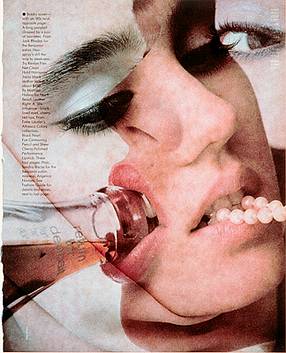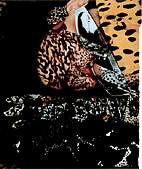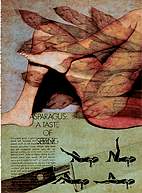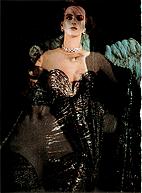|

"The debunking of love and eroticism is an undertaking that has
wider implications than one might think. As soon as a single myth is
touched, all myths are in danger."
— Simone
de Beauvoir
Brigitte Bardot and the Lolita Syndrome
Mythology so deep
in the bones it's Strontium 90. Or, if you prefer, Fay Wray running
from King Kong.
You know how women
lure sailors, cause men to veer off course. Straight lines, straight
men, ship wrecks, home wrecks, let's call the whole thing Descartes.
It was your eyes.
It was the way you took me in with your eyes.
Her hair. A force
of nature, dark, untamed. Entre chien et loup. That wrist, bent
like the David, turns back toward the body. An invitation to touch.
That shoulder nudged upward: Rita Hayworth in Life Magazine.
She is waiting for
you, always. Thinking of you, lying on fresh sheets, she pretends you
are undressing her, stroking her sweet jelly roll. With your mouth,
(your hands, your eyes).
So the mouth then,
Vagina dentata. Painted vulva. Trench. Gash. Cave. Can't you ever look
away?
I am, you wrote,
"the best She." This time I have the pen.
Fire, earthquake,
tsunami, tornado. When a woman asks for a lipstick, it means she's feeling
better, the Red Cross manual said. Cross my heart. After the flood.
I swear.
Dante wrote that
the mouth is where love ends. It begins, he said, in the eyes.
My friend had a
bottle of Jack Daniels in his pocket. Etta James was up on stage singing
"I'd rather go blind than see you walk away from me." We were
finished. B.B. King came on. He sang "The Thrill is Gone."
I drank King Cobra and lip-synched the words.
All those people
who think you're so gruff/tough, have no firsthand knowledge of your
touch. Talk to me.
The point, as I
see it, of pin the tail on the donkey is not to place the thumbtack
on the perfect spot but to trust the blindfolding, the spin into altered
state, the ecstatic wandering.
Blindfolding. A
hand of cards:
 nuclear blast nuclear blast
 firing squad firing squad
 bar on Tenth Avenue bar on Tenth Avenue
 Genet Genet
 de Sade de Sade
 Magritte Magritte
 That look at the solar
eclipse That look at the solar
eclipse
I was on an island,
alone for three days. The forest floor was cold. It rained. I was frozen.
Energy flooded my palms. My hands, made electric, kept me alive. I flew
back to the city, still in that animal grace, with tickets to the Hermitage
show. My body led me to one Picasso, a couple of Gauguins. The best
seeing is never done with the eyes.
L-o-o-k into my
e-y-e-s. You are growing s-l-e-e-p-y. (You are in my
p-o-w-e-r). So what are the rules now?
"My father
had the girl friend," he said, "and one night, unannounced,
he brought her home to dinner. My mother was at the stove cooking this
big pot of spaghetti and sauce. She took one look at the two of them,
and poured the whole mess of sauce all over herself." This girl
friend. This big pot of spaghetti sauce.
You make me feel.
You make me feel. You make me feel like a natural woman. Wo-man.
It's about physiology
really. His blood rushes into his testicles, she faints from lack of
oxygen, stays pulled just too tight. Chemistry of scent, paint on the
skin. Conjure it again, white boy.
Know the joke about
the Pope who only wanted to make love with a blind-deaf woman so she
wouldn't be able to hear or see his desire? You, like Bergman, a minister's
son.
"Ad Reinhardt
was wonderful character who thought that there wasn't anything lower,
there wasn't anything more ludicrous, there wasn't anything more embarrassing
than the relationship between a work of art and the story like the one
we're going into now. What has my going to bed with Frank O'Hara got
to do with the moment that I'm standing in front of my canvas or a piece
of paper with a pencil or a brush?"
— Larry
Rivers,
Drawings and Digressions
You rip up a magazine
I write for.
Do you still have
the grey silk scarves?
|






